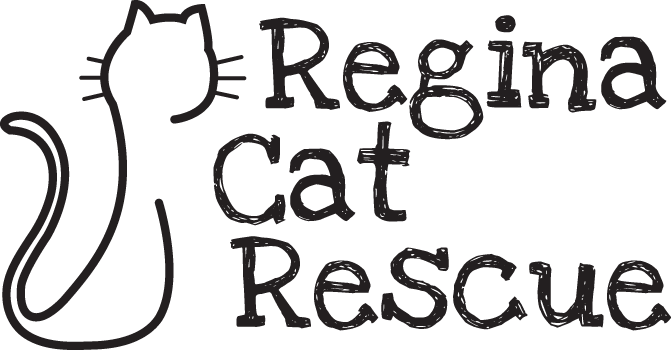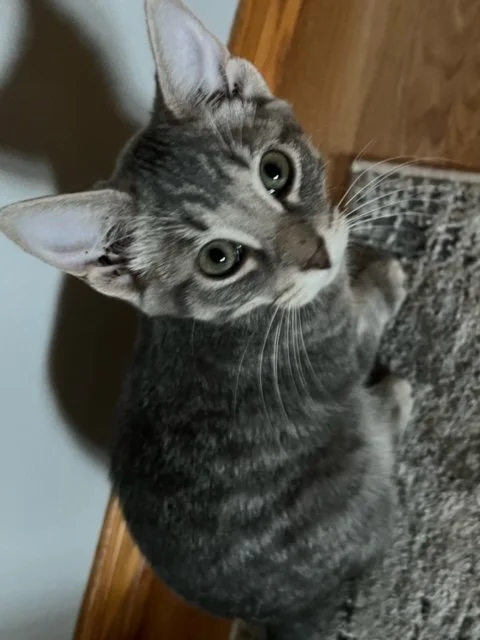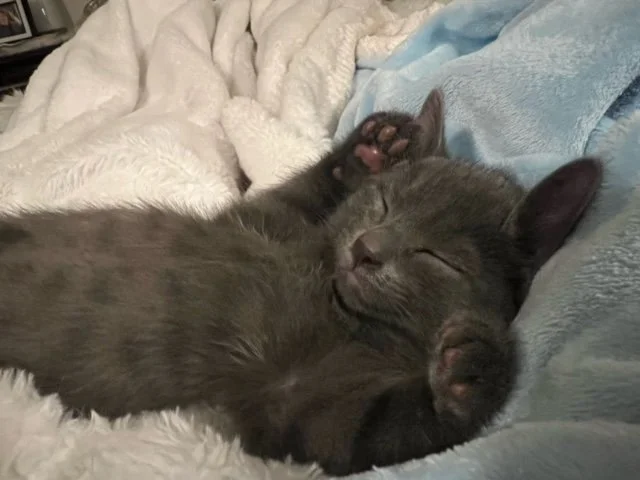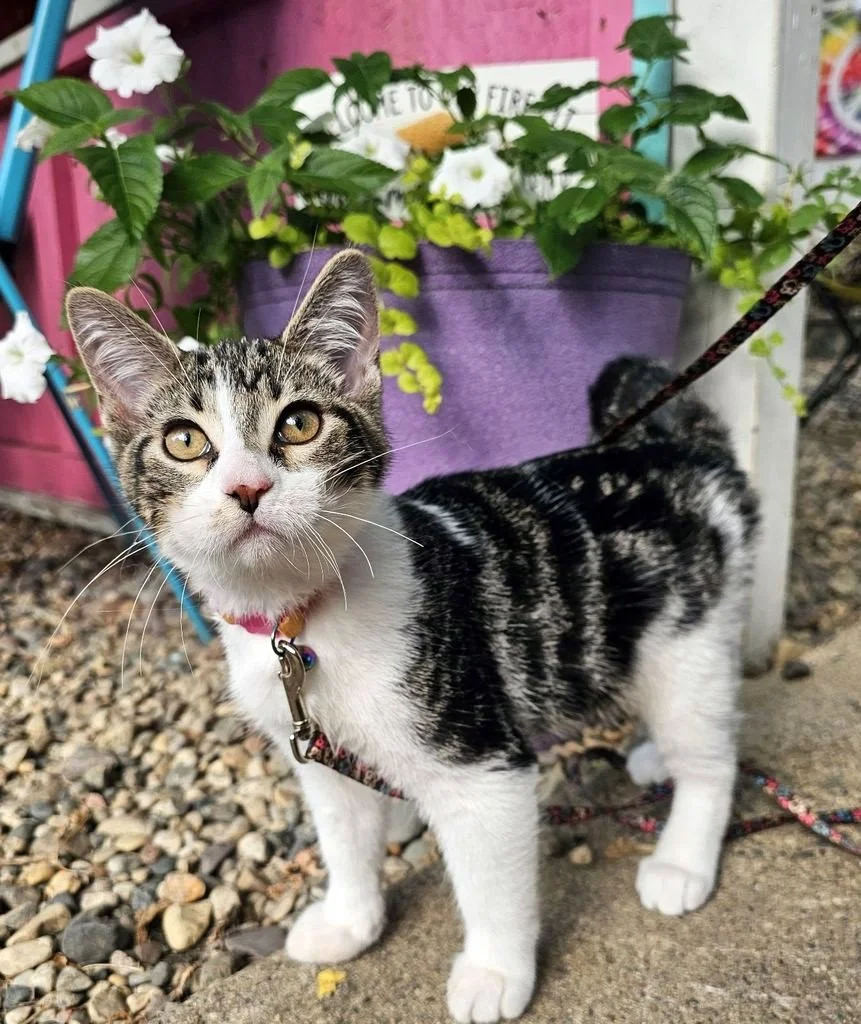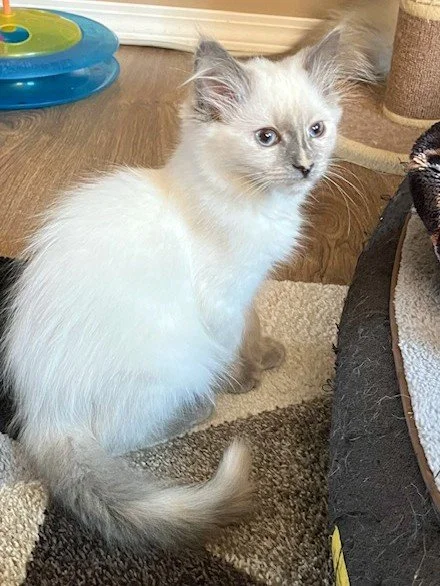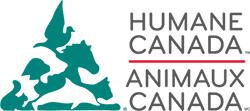Reflecting on 35 years: The evolution of Regina Cat Rescue
/Nov. 18, 2017 marks the 35th anniversary of Regina Cat Rescue’s (RCR) incorporation date, and we wanted to take the opportunity to reflect on the organization’s evolution since 1982 with a special edition of our Meet our Volunteers feature. To help take us back to the eighties, we caught up with one of RCR’s earliest volunteers - Pat Vogt.
Pat joined the organization in 1986 and retired from active volunteering a few years ago, but she continues to donate to RCR and practice trap, neuter, return (TNR) in her neighbourhood. Currently, Pat is a Programmer Analyst at a provincial crown corporation. She enjoys camping and gardening, and although Pat is no longer an active volunteer with RCR, animal welfare is a cause that remains close to her heart.
RCR – Our readers will be familiar with Regina Cat Rescue (RCR), and maybe even People for Animals, but what were the organization’s first name(s)?
PV – The organization started out as “The Association for the Protection of Fur-bearing Animals.” Later it was the “Friends of the Fur-Bearers” before eventually evolving into “People for Animals of Saskatchewan” – which remains Regina Cat Rescue’s legal name today.
RCR – Can you tell us a bit about how PFA began?
PV – People for Animals of Saskatchewan (PFA) was founded by Joanne Craig, who became a good friend of mine. She had learned a lot about the fur industry and recognized there was a great need to educate the public about the industry’s cruelty. Joanne, along with the other founders, formed the group to gather like-minded people to organize and lobby against the fashion fur industry; by that, I mean to oppose the use of fur for uses other than survival or sustenance. Trapping and fur-farming are extremely inhumane – and trapping also kills millions of non-target animals every year in Canada, some of them endangered species. We believed that there was a great need to educate the public, and we hoped that the public would turn against the use of fur, and in many ways, that happened around the world.
Joanne Craig (left) founded what would become Regina Cat Rescue and Pat Vogt (right) was one of the organization's first and longest-serving volunteers.
But it’s been discouraging, as fur has crept back into the stores as trim on coats, on trinkets and even on toys people buy for their cats. A lot of people remain ignorant to the suffering that any fur products entail. Even organizations that focus on companion animals often view animal welfare activities as controversial and won’t get involved, and this is unfortunate and rather ironic because some fur trim is known to be dog and cat fur imported on goods from China, and words can’t adequately describe the horrors those poor animals endure.
RCR – How did you become involved with PFA?
PV - I joined the group in 1986 when a volunteer contacted me after reading a Letter to the Editor in the Regina Leader Post that I wrote about sport hunting. They took me to be an animal welfare activist and they were certainly right about that! So, I can’t take any credit for the formation of the group, but I was one of the people that got on board early – there were only about a half-dozen members at any given time in those days – a few stayed, others came and left after a short time. I was one of the few that remained active and stayed on for many years.
RCR - Why did PFA start working with domestic animals?
PV - Because we were a group of people that cared deeply about animals, it became incidental that we would get involved with local cat rescue. There were abandoned, stray and feral cats and batches of kittens everywhere - it couldn’t be ignored. The Regina Humane Society was overwhelmed, had no sterilization clinic at that time and truly had no choice but to euthanize many cats. So, pet rescue got started simply because here were all these cats that needed to be looked after – the cat over-population crisis was staring us in the face.
So the organizational mandate further evolved to focus on cats, again because the need was great and because of course it’s a very acceptable way to help animals, without any of the stigma that wider animal welfare still faces even today. We did rescue a handful of dogs in the early days, but really weren’t equipped to deal with them very effectively. Other groups were better at dog rescue and PFA was better at the cat rescue. PFA recognized the need to focus on sterilization early on, so it was always the priority. Because many cats were feral, and because TNR has been proven as the most effective way to reduce feral populations, sterilizing and caring for cats in feral colonies became an important arm of the group. The TNR and the foster/adoption programs started out very small but of course have grown in scope.
RCR - In your opinion, what are the biggest achievements or milestones that PFA has achieved?
PV - PFA was on hand to see the last fur retailer close its doors in Regina, because fur coats lost their popularity. For me, that was a huge achievement, even though it certainly wasn’t the end of the fur industry in the long run.
In RCR’s current incarnation and focus, without a doubt, the development of the TNR program and the large number of sterilizations PFA/RCR has facilitated over the years is the most significant achievement. The TNR work filled a gap that the Regina Humane Society simply wasn’t able to focus on, and is vitally important as it attacks the root of the over-population crisis. Also, the placement of many previously unwanted and abandoned cats into loving homes is something very tangible and rewarding that all members can be proud of. Getting charitable status as an organization was also an important milestone - it gave PFA/RCR the ability to fundraise more effectively.
RCR - Over the years, PFA/RCR’s capacity to help cats in need has grown (last year, RCR was able to rescue 473 cats and find homes for 407 cats). What do you think has made this growth possible?
PV - If not for the dedicated volunteers in all aspects of the group, whether fundraising, fostering, caring for the colony cats or governance, those statistics wouldn't be possible. Secondly, as PFA/RCR became more widely known, it gained more support and fundraising was able to grow, along with the number of volunteers. Once the organization achieved charitable status, there were better outcomes when applying for grants like the PetSmart grant. Everything is a learning process and all the lessons learned in all program areas contributed to the growth of the organization.
One of PFA's earliest logos
RCR - Do you have any favourite memories of your time with PFA?
PV - Looking at the period after PFA became dedicated to cat rescue, I would say one of these was getting the news that Canada Revenue Agency had granted PFA charitable status. It had been a long road and a big learning curve to ensure our programs would meet the requirements, to build up the governance side of the organization and to prepare the application. At the time, we were lucky enough to have some guidance from several women who “knew the ropes” that worked with our inexperienced board members, and in fact helped us to put together an actual board of directors and stayed with us throughout the entire process. Receiving the news that we were successful in our application validated our efforts and gave us a lot of optimism about the future of PFA. We were elated!
RCR - What were the most rewarding parts of volunteering with PFA?
PV - The most rewarding part of volunteering for me came from the animals themselves, not surprisingly. Aside from all the stories of satisfactory outcomes for individual cats that came to my attention, there were personal rewards for me with my own little fostering “operation” in my home. When a timid cat or kitten I was fostering “turned the corner,” getting past the shyness and fear and becoming a “teddy bear,” it was like a switch was flipped.
RCR - What were the most challenging aspects of volunteering with animals and PFA?
PV - The most challenging part of volunteering for me was in the area of governance. Organizing always comes with growing pains, and as PFA grew, it was increasingly imperative that the governance grow to meet the challenges. Policies were needed to ensure that the organizational mandate was being met, that the cats that came under PFA’s umbrella were best served, that funds were utilized to get the most “bang for the buck” and so on. Everybody who worked on the board had their own beliefs, values, personalities and ideas. Most weren't experienced in serving on a board. Agreement did not always come easily and emotions could run hot. Every policy that was hammered out was done so with a great deal of work, many revisions and in many cases not everybody was satisfied with the results, but I personally believe that they have served their purpose very well, and some of the heart-wrenching disagreements that were formally the norm, were able to be resolved on the basis of policy. Without the very comprehensive policies that were written and no doubt continue to be revised to meet the needs of the organization, RCR would not have been able to have met the many challenges it has faced.
RCR - Do you have any words you want to share with past and current volunteers?
PV - Volunteers are the heart of any organization that does the kind of work RCR does, and RCR’s volunteers are faced with a never-ending queue of needy animals and a huge job that will never be “done.” I think it’s important to recognize one’s limitations and step back and take a break if need be, or move into another area that doesn’t feel so overwhelming, even if temporarily. “Burn out” is real, and it can mean the loss of volunteers that are always in short supply. Along these lines, I think it’s important to check in with fellow volunteers to see how they’re coping, and “have each other’s back” when things go wrong. I also believe it's always very “illuminating” when volunteers from one area “buddy” with those from another to “walk in their shoes” so to speak. These are educational experiences that can help foster a better understanding of the overall reach of the organization from the grass roots level, as well as a better appreciation of every area’s contributions.
RCR - Are there are any other reflections you’d like to share?
PV - I remember when we were once faced with a difficult decision, brought to the board by one of the colony volunteers: whether to further authorize very expensive veterinary care for a very ill cat. Essentially it meant saving her life, and by then a significant amount had already been spent, so we went ahead, even though we all had reservations. It was very costly to PFA, and sadly, this cat didn't survive. Every life is precious, and it’s in our nature to try to save every cat, but it’s also important to spend the funds wisely, and the members/donors at large had an expectation that the board would ensure that this was so. Many cats could have been sterilized with those funds. But we learned as we went along, and as I recall, this was the point at which PFA implemented a policy that whenever possible, special funds would be set up for cats requiring expensive veterinary care, so that it was clear to the donors how the funds collected would be spent. I think this illustrates some of the difficult challenges associated with pet rescue, and also demonstrates that PFA was maturing as an organization, evolving to meet its challenges while honouring its organizational mandate.
Kitt Katt shortly before she passed away.
RCR – And last, but not least, can you tell us a bit about your own cat family?
PV - I have seven cats – not that I wanted that many, much as I love them! This is my second family of cats – all of them over the years have been rescues. I have a secure cat run that they can access any time, and I have it screened so birds can’t get in. The first cat companion I ever acquired was a tiny, black, injured kitten of 6 weeks old that we found in the middle of the dotted line on a highway late one night back in the 1980’s. We called her “Kitt Katt.” We suspect she may have been hit by a car and she had to get a large wound stitched up, and she was only about the size of a pound of butter. She lived to be 29 years old and just passed away in 2014. I often think of how she certainly would have perished if not for that stroke of luck of seeing her eyes reflected the car lights!
Thanks to Pat Vogt for taking the time to share her experience as a former PFA/RCR volunteer. If you'd like to volunteer with RCR, check out our volunteer job descriptions and apply to get involved!
-Interview by Rachel Molnar
